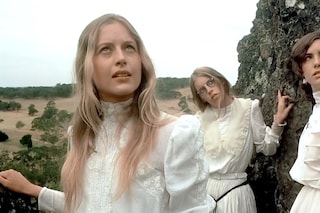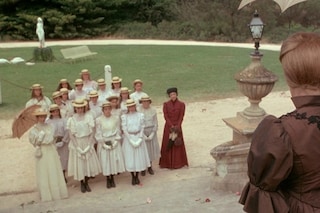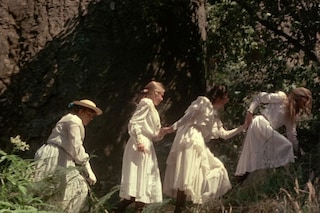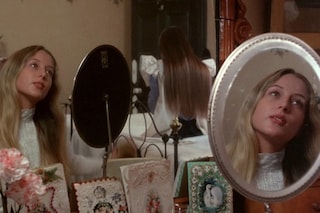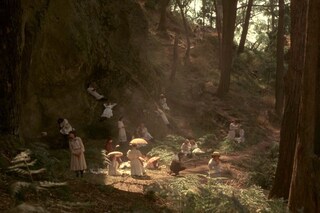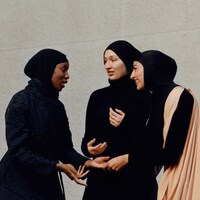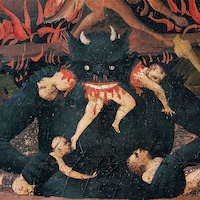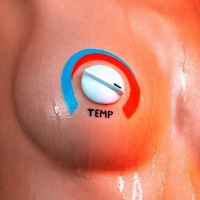The mysterious sad girl aesthetic is all over beauty right now, from the bows and ribbons of Sandy Liang to the coquette characters of Sofia Coppola films – and it can all be traced back to Picnic at Hanging Rock
Heavy-headed dahlias shift slowly in the wind amid the distant shrilling of cicadas. Soft, natural light spills into a bedroom as a young girl in a white linen dress awakes, her silky blonde hair on the pillow loosely framing her ethereal face. The room is hazy. It’s as if we’re immersed in a beautiful, mystical hallucination, or, as is suggested through a childlike voiceover, a dream within a dream. The camera zooms in for close-up shots of doe eyes, flushed cheeks and rosy lips as she turns to look at the curtains blowing gently in the breeze.
Though this melancholic scene could’ve been taken directly from something in Sofia Coppola’s affecting landscape, it was decades before the director’s time. Proto-Virgin Suicides and The Beguiled, Peter Weir’s haunting and poetic 1975 adaptation of Joan Lindsay’s novel, Picnic at Hanging Rock, transports us to Valentine’s Day in the year 1900, on the grounds of an Australian boarding school for girls. Soundtracked by hypnotic panpipes, the film’s opening scenes show girls dressed in puffed and frilled Victorian white lace dresses as they whisper St Valentine’s declarations of love and brush their long hair in preparation for a picnic – during which three of them will mysteriously disappear.
Since its release, Picnic at Hanging Rock has been lauded for the way its dreamlike cinematography encaptures the eerie, beguiling mystery at its centre. With its hyper-feminine, painterly tones, Edwardian dresses and endorsements from the like of Chloë Sevigny (who once said it was her favourite film), it’s no wonder scenes from the cult film are oft used as the visual encompassment of the culture’s current obsession with girlish, coquette, cottagecore and balletcore aesthetics.
But beyond just its clear visual link to fashion and beauty’s current state, Picnic at Hanging Rock is, similarly, a study of girlhood; an examination of the pivotal time in a girl’s life when she becomes a woman. Her sexuality and her desire. Themes women are re-exploring through the subsequent recontextualisation of the aesthetics we once shed in girlhood in order to be taken seriously by society: plaits and pigtails, pastels and pinks.
Moving away from the self-infantilisation and sexualising of innocence that were synonymous with the trend’s last iteration – a Lolita-inspired, Lana Del Rey Born To Die-coded Tumblr era, today’s iteration feels centred around girlhood in its purest of forms: freeing, frivolous and playful. An embracing of gentle fragility, and all the silk ribbons that come with it.
Below, we take a closer look at the ways the film’s influence can be seen in beauty today.

RIBBONS
From the pink silk tied around Miranda’s waist to the bows found in the girl’s hair – both silk and chequered cotton – ribbons are used to demonstrate innocence, youthfulness and curiosity. They could also be clues as to what happened to the missing girls on the rock: in the book of the same name, much was made of the blue ribbons in Edith’s hair and how the other girls thought they weren’t fashionable while Edith showed off in them. In the film, one of the boys who goes to look for the group, Michael, lies down to rest in the same place Edith was seen lying down earlier. Of note are his suspenders: the same shade of blue.
Fast-forward 48 years and the accessory couldn’t be more popular in both fashion and beauty today, seen everywhere from New York’s Sandy Liang, whose models wore their long, blown-out hair dotted with tiny, precise bows for AW23 (the designer later wore her hair similarly for her wedding), to London’s Simone Rocha whose models the same season had tiny red tied ribbons placed below each eye, their ends dangling down to the face to seemingly replicate the trajectory of tears.
On the most recent runways, Mirror Palais had silk ribbon clips adorning their models’ hair, Collina Strada braided pastel-coloured organza ribbon through theirs and silk ribbons were corseted through hair at Christian Siriano (to name but a few). Edith would be happy to note that blue tones are very much on trend.

BRAIDED AND EFFORTLESS HAIR
Hair as a tool of girlish innocence and fragility is prevalent throughout the film. It’s also used as a way to sexualise the girls, in a similar vein to Brigitte Bardot’s pigtails in the 60s and later, Baby Spice and Britney Spears. Hair was similarly used as a symbol in films such as The Virgin Suicides and American Beauty, before in the 90s, pigtails, plaits and infantilised hair were reclaimed by riot grrrls, who ushered in a new era of feminism by celebrating girlishness. Perhaps the best example of this visual play on politics is when Bikini Kill frontwoman Kathleen Hanna wore a mustard yellow crop top with a pair of underwear, pulling her hair back into pigtails, accented by two light pink ribbon bows.
Today, as seen on the runways, hair has become intrinsically linked to our reclamation of girlhood and recontextualisation of its aesthetics. “For so long femininity has been looked down upon and seen as frivolous, and now we’re all coming together to embrace those parts of ourselves,” model Camri Hewie said in Kristen Bateman’s piece exploring the rise of coquette hair. “We’re dressing in a way our younger selves would appreciate.”
The film’s final scene shows Miranda smiling and waving to her teacher before she turns away toward the rock, leaving viewers with the memory of her long wavy blonde hair blowing in the wind, half of it pulled back into a loose mermaid plait. The undone, natural style is similar to that of the “effortless” hair – tousled waves that give the impression of natural texture – we saw on the runway at Chanel, Louis Vuitton and Miu Miu in Paris this season.

DEWY SKIN
Before there was Glossier or Rhode, there was the beauty routine of the Appleyard schoolgirls: upon waking, simply bathe your face in a basin filled with floral water and get flushed, natural rosy blushed cheeks from getting lost among the rocks in the desertous heat of the Australian outback.
The no-make-up make-up look has been an ongoing trend in recent years, counteracting that of the heavily contoured and matte faces circa mid-2010s. Whether it is being called dolphin skin, glass skin or glazed donut skin, that dewy glow has dominated with an increased focus has been placed on ‘skin-first’ – prep prior to the application of make-up that ensures a bright, glowing base.
Although the ‘natural beauty’ look comes with its own set of issues – for one, the amount of time, money and energy that it takes to maintain a perfect dewy, glowing complexion can be extensive – at it’s best, it embodies an idea of self-acceptance and a simplicity that doesn’t require millions of products to achieve. The look has been a staple on the runway recently including this season at Molly Goddard where the models had bare, dewy skin thanks to natural skincare brand Emma Lewisham.

FLUSHED CHEEKS AND LIPS
If you look at all the micro-trends of the last year or so – from coquette balletcore and cottagecore make-up to the strawberry girl and tomato girl aesthetic, crying girl, cold girl, sunburnt girl, and so on – what they all have in common is the rosy, blush-brushed cheeks and peach or pink lips that mirror the ultra-feminine, romantic beauty looks seen on the girls from Picnic at Hanging Rock.
On TikTok, these looks often follow the same formula: skin is kept soft, simple, and set with powder and eyes are accentuated with white eyeliner on the waterline for a doe-eyed effect. Liquid blush has seen a huge surge in popularity, in part because of these trends. Selena Gomez’s brand Rare Beauty has sold $70 million in blush, while products like Charlotte Tilbury’s Beauty Blush Wands, Benetint and Ciaté London Dewy Blush Tint have all seen success on social media as well.
Where today’s Gen Zers are using Too Faced or lip tints from Wonderskin for the perfect pout, outtakes from the film see the girls of Appleyard brushing red flower petals against their lips to add a pink tint. Prior to TikTok’s obsession with the trend, Picnic at Hanging Rock’s beauty influence can be seen in films such as Romeo + Juliet, Lost in Translation and Little Women.


